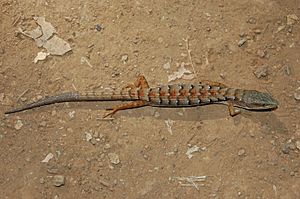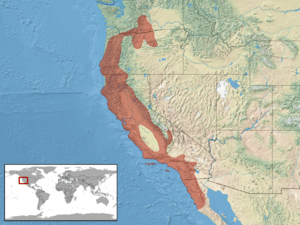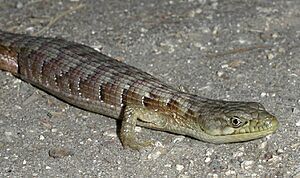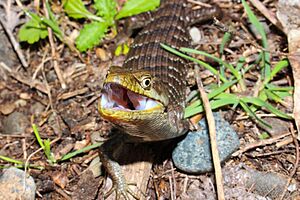Southern alligator lizard facts for kids
Quick facts for kids Southern alligator lizard |
|
|---|---|
 |
|
| Conservation status | |
| Scientific classification | |
| Genus: |
Elgaria
|
| Species: |
multicarinata
|
 |
|
| Synonyms | |
|
|
The southern alligator lizard (Elgaria multicarinata) is a common type of lizard found along the Pacific coast of North America. These lizards live in many different places, from Baja California in Mexico all the way up to Washington State in the USA. You can find them in grassy areas, forests, and even in cities! If it's a dry place, they often hang out near water. There are five different kinds, or subspecies, of southern alligator lizards.
Contents
Types of Southern Alligator Lizards
Scientists have found five main types of southern alligator lizards. They are all slightly different, but belong to the same species.
- Elgaria multicarinata ignava (Van Denburgh, 1905)
- Elgaria multicarinata multicarinata (Blainville, 1835)
- Elgaria multicarinata nana (Fitch, 1934)
- Elgaria multicarinata scincicauda (Skilton, 1849)
- Elgaria multicarinata webbii (Baird, 1859)
Naming the Alligator Lizard
The name Elgaria might come from a person named "Elgar." It could also be a fun play on the word "alligator." The second part of its scientific name, multicarinata, means "many keels." This refers to the special bumpy scales on its back.
The common name "alligator lizard" comes from its scales. Like alligators, these lizards have scales on their back and belly that are strengthened by bone. This makes them tough!
One of the subspecies, webbii, is named after Thomas Hopkins Webb. He was a secretary for a survey team that explored the border between the United States and Mexico a long time ago. The name scincicauda means "skink tail."
What Southern Alligator Lizards Look Like
Southern alligator lizards are usually about 3 to 7 in (8 to 18 cm) long from their nose to the start of their tail. But if you include their long tail, they can be as long as a foot (30 cm)! They have a thick, round body with small legs. Their tail is very long and can even grab onto things.
Like many lizards, they can drop their tail if a predator grabs it. This helps them escape to safety. These lizards can live for 10 to 15 years, and they do well when cared for by humans.
Their color can change a lot. They might be brown, gray, green, or yellowish on top. Sometimes they have red spots on their back. They usually have 9 to 13 dark stripes across their back, sides, and tail. These stripes often have white spots next to them.
The scales on their back, sides, and legs are keeled, meaning they have a ridge like the keel of a boat. There are 14 rows of scales across their back. A line of smaller, grainy scales runs along each side of their body. This creates a fold that lets their body stretch out. This is helpful when they eat a big meal or when a female is carrying eggs.
Where They Live
The southern alligator lizard lives along the Pacific coast of North America. You can find them from Washington State down to Baja California. They live in many different places, like grasslands, open forests, and even in suburban areas and cities. They can also be found in deserts, especially near rivers. These lizards are very common in oak woodlands in the foothills. They often hide under rocks, logs, or other things on the ground.
What They Eat
E. multicarinata eats many small creatures. Their diet includes arthropods (like insects and spiders), slugs, other lizards, and small mammals. Sometimes, they might even eat young birds or their eggs.
Behavior and Reproduction
Southern alligator lizards are often seen near people's homes, like in yards or garages. They usually look for food in the mornings and evenings. If you try to pick one up, they might bite or release a smelly liquid to defend themselves. It's best to observe them from a distance.
Mating usually happens in the spring, from April to May. In warmer places, they might breed all year long. Females lay their eggs between May and June. The eggs hatch in late summer and early fall. Females often lay two groups of eggs each year. They like to lay them in rotting wood or plants to keep the eggs warm. The mother lizard will stay and guard her eggs until they hatch.
Images for kids
See also
 In Spanish: Lagartija lagarto meridional para niños
In Spanish: Lagartija lagarto meridional para niños






